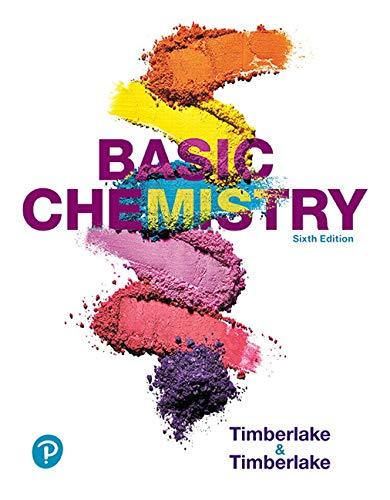
Concept explainers
(a)
Interpretation: We need to identify GeH4 as polar or non-polar molecule.
Concept Introduction : The
(b)
Interpretation: We need to identify I2 as polar or non-polar molecule.
Concept Introduction : The chemical bonds can be classified as ionic bond and covalent bonds. Ionic bonds are formed between cation and anion. Here both of these are charged ions. On the contrary, covalent bond is formed by equal sharing of electrons. Further covalent bond can be classified as polar and non-polar covalent bond.
(c)
Interpretation: We need to identify CF3Cl as polar or non-polar molecule.
Concept Introduction : The chemical bonds can be classified as ionic bond and covalent bonds. Ionic bonds are formed between cation and anion. Here both of these are charged ions. On the contrary, covalent bond is formed by equal sharing of electrons. Further covalent bond can be classified as polar and non-polar covalent bond.
(d)
Interpretation: We need to identify PCl3 as polar or non-polar molecule.
Concept Introduction : The chemical bonds can be classified as ionic bond and covalent bonds. Ionic bonds are formed between cation and anion. Here both of these are charged ions. On the contrary, covalent bond is formed by equal sharing of electrons. Further covalent bond can be classified as polar and non-polar covalent bond.
(e)
Interpretation: We need to identify BCl3 as polar or non-polar molecule.
Concept Introduction : The chemical bonds can be classified as ionic bond and covalent bonds. Ionic bonds are formed between cation and anion. Here both of these are charged ions. On the contrary, covalent bond is formed by equal sharing of electrons. Further covalent bond can be classified as polar and non-polar covalent bond.
(f)
Interpretation: We need to identify SCl2 as polar or non-polar molecule.
Concept Introduction : The chemical bonds can be classified as ionic bond and covalent bonds. Ionic bonds are formed between cation and anion. Here both of these are charged ions. On the contrary, covalent bond is formed by equal sharing of electrons. Further covalent bond can be classified as polar and non-polar covalent bond.
Want to see the full answer?
Check out a sample textbook solution
Chapter 10 Solutions
Basic Chemistry Plus Mastering Chemistry With Pearson Etext -- Access Card Package (6th Edition)
- 2. Provide reagents/conditions to accomplish the following syntheses. More than one step is required in some cases. a. CH3arrow_forwardIdentify and provide an explanation that distinguishes a qualitative and quantitative chemical analysis. Provide examples.arrow_forwardIdentify and provide an explanation of the operational principles behind a Atomic Absorption Spectrometer (AAS). List the steps involved.arrow_forward
- Instructions: Complete the questions in the space provided. Show all your work 1. You are trying to determine the rate law expression for a reaction that you are completing at 25°C. You measure the initial reaction rate and the starting concentrations of the reactions for 4 trials. BrO³¯ (aq) + 5Br¯ (aq) + 6H* (aq) → 3Br₂ (l) + 3H2O (l) Initial rate Trial [BrO3] [H*] [Br] (mol/L) (mol/L) | (mol/L) (mol/L.s) 1 0.10 0.10 0.10 8.0 2 0.20 0.10 0.10 16 3 0.10 0.20 0.10 16 4 0.10 0.10 0.20 32 a. Based on the above data what is the rate law expression? b. Solve for the value of k (make sure to include proper units) 2. The proposed reaction mechanism is as follows: i. ii. BrО¸¯ (aq) + H+ (aq) → HBrO3 (aq) HBrO³ (aq) + H* (aq) → H₂BrO3* (aq) iii. H₂BrO³* (aq) + Br¯ (aq) → Br₂O₂ (aq) + H2O (l) [Fast] [Medium] [Slow] iv. Br₂O₂ (aq) + 4H*(aq) + 4Br(aq) → 3Br₂ (l) + H2O (l) [Fast] Evaluate the validity of this proposed reaction. Justify your answer.arrow_forwardе. Д CH3 D*, D20arrow_forwardC. NaOMe, Br Brarrow_forward
- Please predict the products for each of the following reactions: 1.03 2. H₂O NaNH, 1. n-BuLi 2. Mel A H₂ 10 9 0 H2SO4, H₂O HgSO4 Pd or Pt (catalyst) B 9 2 n-BuLi ♡ D2 (deuterium) Lindlar's Catalyst 1. NaNH2 2. EtBr Na, ND3 (deuterium) 2. H₂O2, NaOH 1. (Sia)2BH с Darrow_forwardin the scope of ontario SCH4U grade 12 course, please show ALL workarrow_forwardIs the chemical reaction CuCl42-(green) + 4H2O <==> Cu(H2O)42+(blue) + 4Cl- exothermic or endothermic?arrow_forward
 Chemistry: The Molecular ScienceChemistryISBN:9781285199047Author:John W. Moore, Conrad L. StanitskiPublisher:Cengage Learning
Chemistry: The Molecular ScienceChemistryISBN:9781285199047Author:John W. Moore, Conrad L. StanitskiPublisher:Cengage Learning
